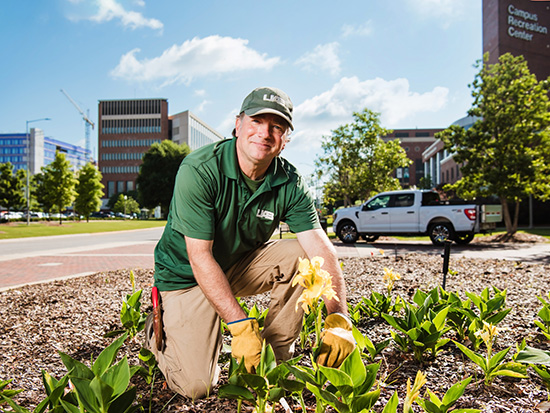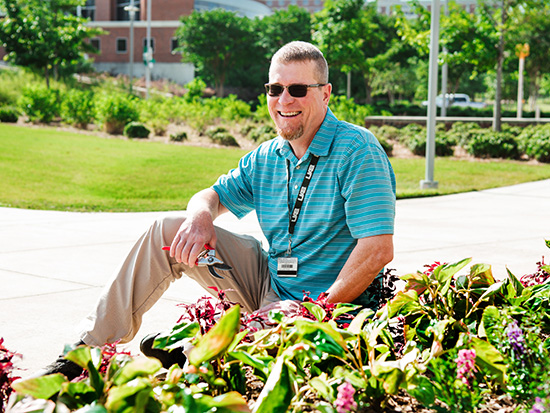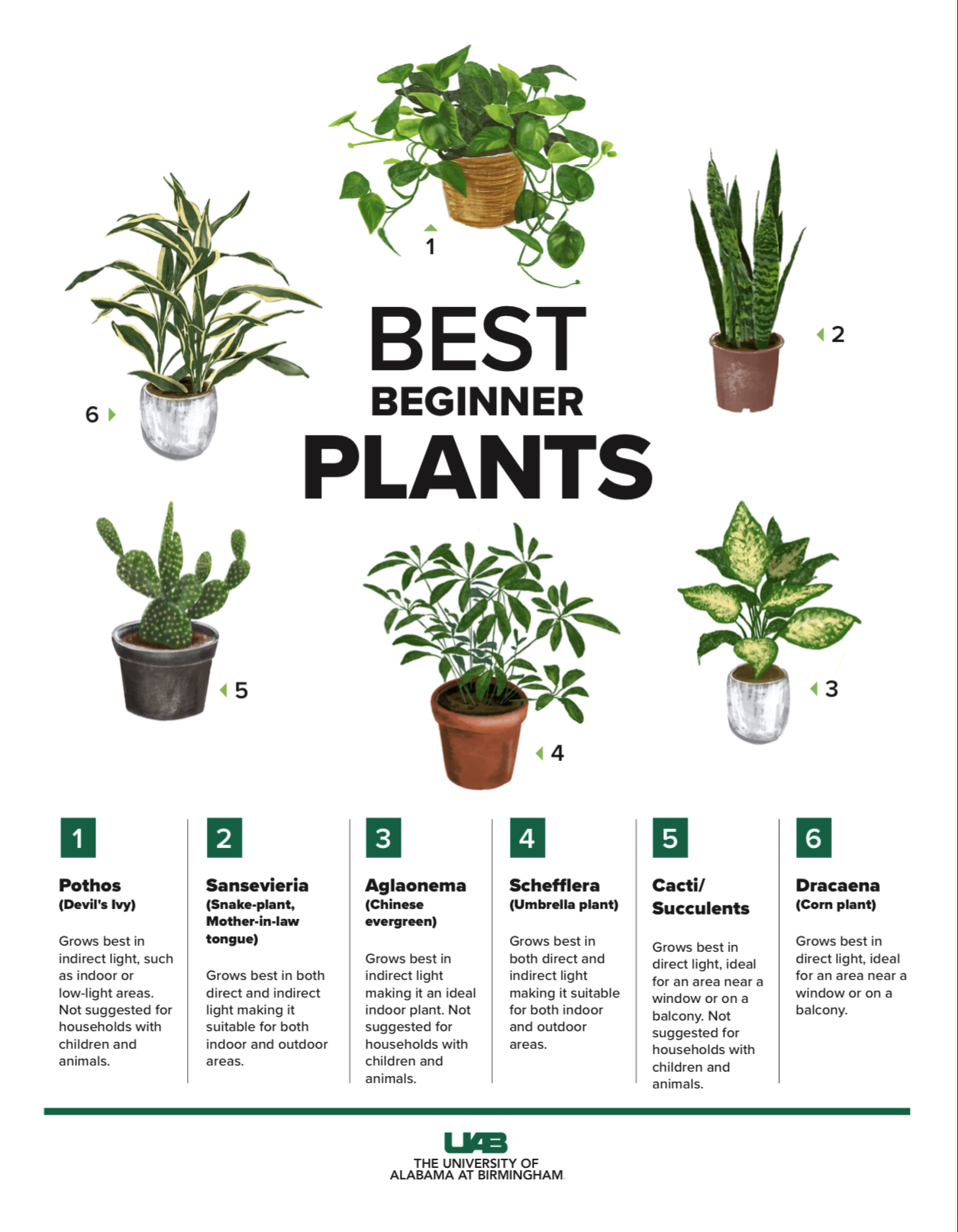Media contact: Tehreem Khan
 Photography: Jennifer Alsabrook-TurnerApril showers bring May flowers, but what do May flowers bring? Experts at the University of Alabama at Birmingham say gardening can improve both mental and physical health, whether working outdoors on a garden or caring for indoor plants.
Photography: Jennifer Alsabrook-TurnerApril showers bring May flowers, but what do May flowers bring? Experts at the University of Alabama at Birmingham say gardening can improve both mental and physical health, whether working outdoors on a garden or caring for indoor plants.
Many believe that, to be a gardener, they need a green thumb; but UAB grounds coordinator Scott Glenn says there is no such thing.
“There is no such thing as having a green thumb,” Glenn said. “Everyone can garden with enough patience and practice.”
In the beginning phase of gardening, “keeping it simple” is the best mindset to have. The team recommends starting slowly with just a few plants and focusing on keeping the space clean and tidy.
“When you first start out, keep the yard and plants tidy; you can always learn and customize as you go,” said David Lovell, UAB grounds manager.
Every plant is different, which makes both indoor and outdoor gardening fun. Being patient and understanding that gardening is a learning experience is key to an enjoyable gardening experience.
“Gardening teaches you humility,” Lovell said. “Sometimes, no matter what you do, the plant will still just die; but that is a part of nature. You must always be flexible and willing to adjust whenever things do not go as planned.”
 Margaret Canter, Ph.D.Rooted in mental heath
Margaret Canter, Ph.D.Rooted in mental heath
Gardening is great for the environment, and it can be beneficial for mental and physical health. Margaret Canter, Ph.D., assistant professor in the UAB Department of Psychology, says hobbies like gardening are shown to reduce symptoms of anxiety and depression, as well as increase attention span.
Spending time outside doing physical activities like gardening can improve sleep, which will help overall health.Caring for indoor plants has health benefits including cleaning the indoor air.
“Keeping indoor and outdoor plants can be a natural mood booster,” Canter said. “There is a lot of research to support that spending time outdoors helps regulate sleep cycle, which is vital for good mental health.”
She says gardening can give people a sense of purpose because they have something to care for other than themselves ¾ this is where the terms “plant pet” and “plant parent” come from.
“During COVID-19, many people found that caring for a plant helped them feel more connected when they were experiencing isolation,” Canter said.
Caring for a plant can be a distraction for some people and can provide comfort during difficult mental health moments. Canter says plants, like pets, are dependent upon the caregiver for nutrients; but they do not require the same level of commitment needed as when caring for a pet.
“Caring for something else can distract you from your own problems and help you feel productive overall,” Canter said.
Canter says developing any hobby can help with social connection. Studies show that being involved in a community garden has a greater positive impact on mental health than individual gardening because of the social component.
“When people develop gardening as a hobby, they have the opportunity to connect with a new community, which allows people to grow their social network and connect over common interests,” Canter said.
Overall plant ownership can be fun and beneficial. There is no magic number on how many plants will improve mental health. Canter suggests everyone should find the number of plants that fits their lifestyle.
“I don’t think there is a magic number. You want enough to keep you busy but not so many that you feel overwhelmed,” Canter said. “Everyone needs to find the magic number of plants that makes them happy.”
 Photography: Jennifer Alsabrook-TurnerSowing the seeds outdoors
Photography: Jennifer Alsabrook-TurnerSowing the seeds outdoors
Timing for gardening is important. The UAB grounds team expressed caution in planting too early due to cold fronts and frosts. They recommend planting flowers and vegetable gardens in mid-April.
“It depends on what you are planting; but for vegetables and flower gardens, we recommend planting them after mid-April,” Lovell said. “Trees and shrubs take better when planted in the winter because it gives the roots a chance to settle in the ground before the extreme heat comes through.”
Keep indoor plants simple
Certain tools are needed to begin growing indoor plants. They recommend keeping it simple at the start.
“When you are first starting out, you do not need anything too fancy,” Glenn said. “A hand shovel, some gloves and a pot will get you started.”
When looking for a pot, choose one that has a drainage hole. This allows the water to seep out, which helps prevent root rot and bacteria buildup in the bottom of the pot. After potting the plant, avoid watering the plant every day as this can lead to over-watering. The UAB grounds team recommends sticking to a two-week watering schedule for indoor plants.
“Start out with watering the plant every 10 days; but if you can push it to two weeks, that’s probably best,” Glenn said. “Water it, really get it wet, then leave it alone.”
The team says fertilizer is not always necessary for houseplants; however, if a plant owner is interested in using fertilizer, the best practice is to get a liquid fertilizer to feed the plant in small amounts.
“What most people will do is add a little bit of liquid fertilizer in the watering can and kind of spoon-feed just a little bit every time you water the plant,” Lovell said.
 Graphic by Jody PotterPotting possibilities indoors
Graphic by Jody PotterPotting possibilities indoors
Learning what to plant is just as important as learning how to plant it. When shopping for indoor plants, the grounds team recommends checking labels for the level of light needed and toxicity to children and animals.
Below are recommended beginner indoor plants and how to care for them.
- Aglaonema , commonly known as Chinese evergreen, has leaves that are lance-shaped and dark green with light green blotches. They are great indoor plants because they require indirect light and are known for their ability to cleanse rooms of air toxins. This plant is easy to over-water, especially if it is not placed in a sunny spot, so be sure to keep it on a watering schedule.
- Schefflera arboricola, also known as the umbrella plant, is an evergreen shrub characterized by its oval leaves arranged in the shape of an umbrella. These plants require bright indirect light, so they are best kept indoors near a window or on a balcony. The umbrella plant needs to be watered only when the soil is completely dry. This plant also enjoys having its leaves misted with water.
- Sansevieria trifasciata goes by a few different names, including snake plant or mother-in-law’s tongue. This plant is a drought-tolerant plant characterized by its thick, stemless leaves. It can survive in various light conditions and needs to be watered only when its soil gets dry. The snake plant is known to get dusty, so it is recommended that its leaves get wiped down on both sides often.
- Dracaena fragrans, commonly known as corn plant, is a common household plant recognized by its spear-shaped leaves with dark and light green stripes. As the species names suggests, this plant is very fragrant when it flowers; however, it rarely flowers indoors. The common name comes from the plant’s appearance as it resembles a corn stalk. This plant is best kept near a window or on a balcony where it can receive bright light.
- Cacti and succulents come in many different types; they are great beginner plants because they do not need to be watered regularly. These plants thrive in direct sunlight, so they are perfect for bright rooms and balconies. Some succulents can be toxic to children and animals, and cacti’s sharp needles can be dangerous, so it is important to be aware of this before purchasing.
- Epipremnum aureum, commonly known as golden pothos, is an evergreen variegated vine characterized by its cascading leaves. It has also been called devil’s ivy because it is nearly impossible to kill. Low light or indirect light is the ideal condition for this plant, making it perfect for dorm rooms and apartments.